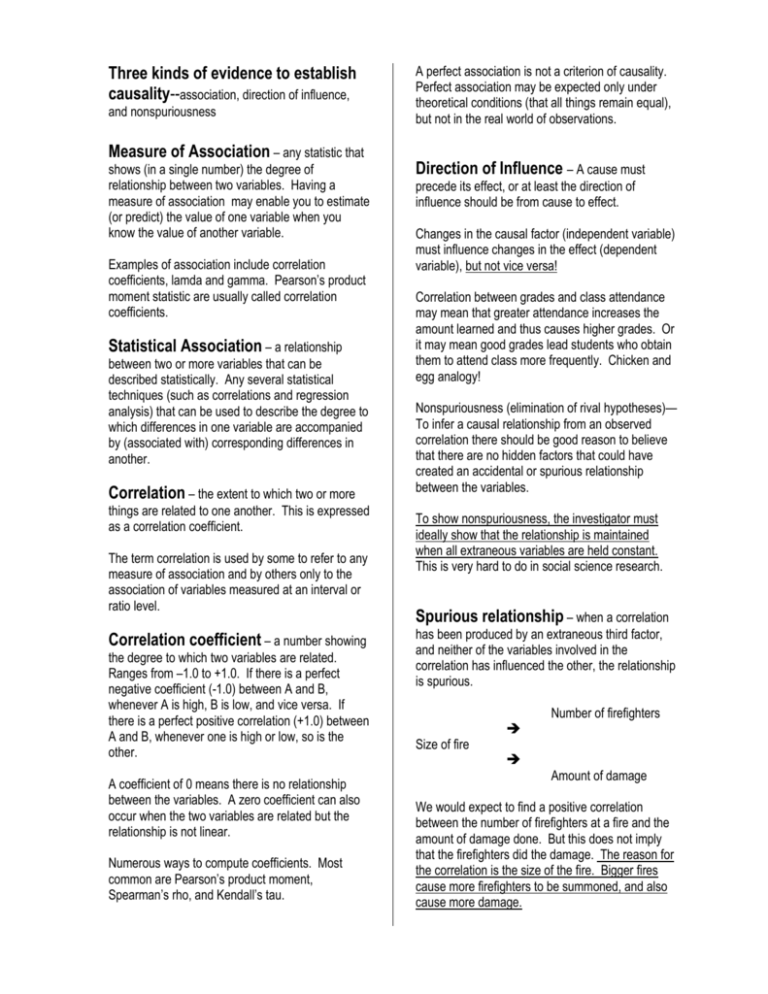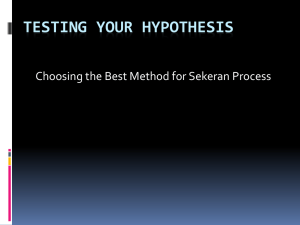Three kinds of evidence to establish causality
advertisement

Three kinds of evidence to establish causality--association, direction of influence, and nonspuriousness Measure of Association – any statistic that shows (in a single number) the degree of relationship between two variables. Having a measure of association may enable you to estimate (or predict) the value of one variable when you know the value of another variable. Examples of association include correlation coefficients, lamda and gamma. Pearson’s product moment statistic are usually called correlation coefficients. Statistical Association – a relationship between two or more variables that can be described statistically. Any several statistical techniques (such as correlations and regression analysis) that can be used to describe the degree to which differences in one variable are accompanied by (associated with) corresponding differences in another. Correlation – the extent to which two or more things are related to one another. This is expressed as a correlation coefficient. The term correlation is used by some to refer to any measure of association and by others only to the association of variables measured at an interval or ratio level. Correlation coefficient – a number showing the degree to which two variables are related. Ranges from –1.0 to +1.0. If there is a perfect negative coefficient (-1.0) between A and B, whenever A is high, B is low, and vice versa. If there is a perfect positive correlation (+1.0) between A and B, whenever one is high or low, so is the other. A coefficient of 0 means there is no relationship between the variables. A zero coefficient can also occur when the two variables are related but the relationship is not linear. Numerous ways to compute coefficients. Most common are Pearson’s product moment, Spearman’s rho, and Kendall’s tau. A perfect association is not a criterion of causality. Perfect association may be expected only under theoretical conditions (that all things remain equal), but not in the real world of observations. Direction of Influence – A cause must precede its effect, or at least the direction of influence should be from cause to effect. Changes in the causal factor (independent variable) must influence changes in the effect (dependent variable), but not vice versa! Correlation between grades and class attendance may mean that greater attendance increases the amount learned and thus causes higher grades. Or it may mean good grades lead students who obtain them to attend class more frequently. Chicken and egg analogy! Nonspuriousness (elimination of rival hypotheses)— To infer a causal relationship from an observed correlation there should be good reason to believe that there are no hidden factors that could have created an accidental or spurious relationship between the variables. To show nonspuriousness, the investigator must ideally show that the relationship is maintained when all extraneous variables are held constant. This is very hard to do in social science research. Spurious relationship – when a correlation has been produced by an extraneous third factor, and neither of the variables involved in the correlation has influenced the other, the relationship is spurious. Size of fire Number of firefighters Amount of damage We would expect to find a positive correlation between the number of firefighters at a fire and the amount of damage done. But this does not imply that the firefighters did the damage. The reason for the correlation is the size of the fire. Bigger fires cause more firefighters to be summoned, and also cause more damage. Case Study - Patricia Kendall (1986) presents an interesting example of nonspurious relationship form a study conducted in the 1950s. E.g., An increase in one’s education level will result in a decrease in the level of prejudice. Found that male graduates of Ivy League schools “were more successful in their later professional careers, as defined by their annual income, than those who graduated from other colleges and universities.” Immigrants to USA tend to be more educated than immigrants from Asia. She claimed that the relationship between attendance at an Ivy League school and professional success remained when family SES was held constant. 1. If-then (conditional) Statements – If a person has high level of education, then s/he will have a low level of prejudice. 2. Mathematical Statements – Y = f(x). Y is a function of x. 3. Continuous Statements – the greater the X, the greater (or lesser) the Y. 4. Difference Statements – People with high education are less prejudiced than people with low education. But can readily identify extraneous variables that could make this a spurious relationship. For example, wealthy parents could better afford to send their sons to Ivy League schools and also had the business and professional connections that could help their sons become successful in their careers. Check out example of heart attacks on page 83!! Drivers and conductors of double deckers buses in London. Exercise can reduce heart attacks. … but difficult to establish! Examined uniforms issued to drivers and conductors. Found that drivers tended to be issued larger uniforms. Amount of exercise, weight, age as independent variables and heart attacks as dependent variables. Exercise – conductors or drivers? Extraneous variables – all variables that are not the objects of the research. Hypothesis – An expected but unconfirmed Ways of Stating Hypothesis Re-Write following hypothesis: Women are underpaid Women tend to receive lower pay than men. Poverty breeds illiteracy If a nation’s average family income is low, then its illiteracy rate will tend to be low. Also to complement by conditional – if a nation’s average family income is high, then literacy rate will tend to be high. Class activity – Rewrite hypo 1. Among elderly, there is a relationship between marital status and happiness. relationship between two or more variables. 2. Highly educated people are politically liberal. All hypo should speculate about the nature and form of a relationship. 3. Catholics attend church often. An adequate hypo statement about 2 variables should indicate which variable predicts or causes the other, and how changes in one variable are related to changes in the other. 4. Frequent dating lowers the grades of females. 5. Among male students, alcohol consumption affects grades. 6. Study time is related to grades among seniors only. Females do not come first, two females do not add up to one male. Numbers are merely labels. 7. Students who attend class regularly generally do better. Ordinal Scale – ranks subjects (puts them in For 4 – 7, sketch a graph or construct a table with hypothetical data that support the hypothesis. Two common mistakes are (10 the failure to specify exactly how the variables are related, and (2) the inappropriate or erroneous labeling of variables. For example, some students may say that marital status affects happiness without indicating who is happier than whom. Other students may use variable categories to label variables saying, for example, that “elderly” or “attending class regularly” are variables, when these labels do not imply variation. Null Hypothesis – The hypothesis that 2 or more variables are not related. In accumulating evidence that the null is false, you indirectly demonstrate that the variables (in the hypo) are related. Hypo Testing – Classical approach to assessing the statistical significance of findings. Involves comparing empirically observed sample findings with theoretically expected findings-expected if the null hypo is true! This comparison allows you to compute the probability that the observed outcomes could have been due to chance alone! That is why many research studies do not claim that this causes this but that there is a high probability that this leads to this…. Measurement Nominal Scale – numbers stand for names but have no order or value. Also called categorical variables. E.g., Coding female = 1, male = 2. order) on some variable. The differences between the ranks need not be equal (as they are in an interval scale). Team standings or scores on an attitude scale (e.g., highly concerned, very concerned, concerned, and so on) are examples. Interval Scale – A scale of measurement that describes variables in such a way that the distance between any two adjacent units of measurement (or intervals) is the same but in which there is no meaningful zero point. Scores on an interval scale can be added and subtracted but not multiplied and divided. E.g., F temperature scale is an interval scale because the difference, or interval, say 72 and 73 degrees is the same as that between 20 below and 21 below. Because there is no true zero point (zero is just a line on the thermometer), it is an interval, not a ratio, scale. There is zero, of course, but it is not a true zero; when it’s zero degrees outside, there is still warmth, more than when it’s 20 below. Ratio Scale – a measurement or scale in which any two adjoining values are the same distance apart, and in which there is a true zero point. The scale gets its name from the fact that one can make ratio statements about variables measured on a ratio scale. E.g., height measured in inches is measured on a ratio scale. This means that the size of the difference between 60 and 61 inches is the same as 66 and 67 inches tall. And, because there is a true zero point, 70 inches is twice as tall as 35 inches (ratio of 2:1). The same kind of ratio statements cannot be made, for example, about measures on an ordinal scale. E.g., the person who is the second tallest in the group is probably not as twice as tall as the person who is the fourth tallest.







